This bridge is recognized as the first iron bridge in the world. This rural region of England was an important industrial area thanks to coal deposits near the surface. In 1776 the nearest bridge that enabled people and goods to pass over the River Severn was two miles away at Buildwas. There was a ferry crossing, but the trip was difficult and dangerous especially in winter. In 1776, an Act to build a bridge to remedy this situation received Royal Assent.
Bridges
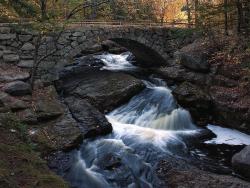
"Some of New Hampshire's most aesthetically pleasing yet least appreciated structures are stone arch bridges."
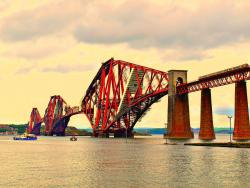
"The majestic Forth Bridge ... symbolises the tremendous achievements of Victorian engineers and the immense strides made in the technique of bridge design and construction since the dawn of the Railway Age..."
- Derrick Bennett, Bridges: Great Buildings of the World
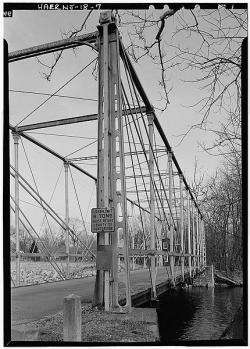
"Fink's truss design was one of a number of early patented solutions to [the problem of how] to carry a massive, moving weight (a train) over long spans (to avoid the expense of building piers and obstructing waterways) on easily erected bridges (often in rough terrain) with good long-term economy..."
- Kent Farnow Smith, "America's Oldest Functioning Iron-Truss Bridge," 1978
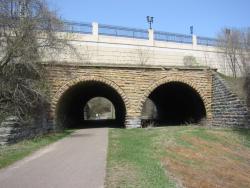
Designed by William A. Truesdell, a railroad engineer, the Seventh Street Improvement Arches celebrates the engineering application of mathematics to improve living conditions.

Conceived as one of the major structures on the Prussian Eastern Railway, the Old Wisla Bridge at Tczew originally consisted of six wrought iron spans. Due to Germany's invasion of Poland at the beginning World War II in 1939, only three original spans remain today. These remaining spans represent a unique technical monument of civil engineering achievements in the mid-nineteenth century.
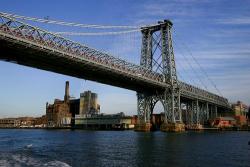
When opened in 1903, the 1,600 foot long main span of the Williamsburg Bridge was the world's longest suspension span, surpassing the nearby Brooklyn Bridge by only 4.5 feet. The Williamsburg Bridge remained the world's longest suspension bridge span for 21 years until the opening of the Bear Mountain Bridge in 1924. The Williamsburg Bridge has two unsuspended side spans of 596.5 feet, each supported from below by trussed towers, giving the bridge an overall length of 2,793 feet. The four main suspension cables are 18.75 inches in diameter and each composed of over 10,000 wires.
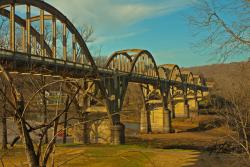
When this 1,850-foot concrete-arch highway bridge was built on the White River in a remote region of northern Arkansas - prior to the construction of upriver, flood-control dams - flash floods occurred frequently, sometimes causing the water to rise as much as one foot per hour. Construction under these conditions presented a clear danger, so project managers specified both a design and an innovative construction method appropriate to the problem of building across a perilous stretch of unpredictable river.
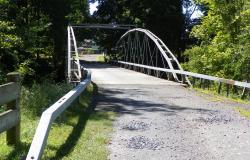
The Whipple Bowstring Truss Bridge was built from a design patented in 1841 by Squire Whipple. Whipple was the first person to understand the stresses in truss members and he developed the first theoretical formula to calculate stresses in the articulated truss. His bowstring truss was the first to use cast iron for compression and wrought iron for tension membranes.
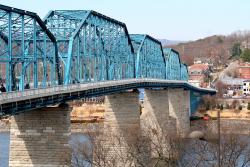
The structure has two segments: an East Channel bridge consisting of four 175-foot spans and three 240-foot spans crossing from Harrisburg to City Island; and a West Channel bridge, consisting of seven 175-foot spans crossing from City Island to Wormleysburg.
With 15 truss spans totaling 2,820 feet, the Walnut Street Bridge is the finest and largest surviving example of the standardized Phoenix wrought-iron truss bridges produced from 1884 to 1923.
Innovations
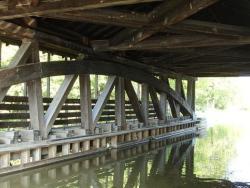
The significance of the 15-mile Whitewater Canal was not in its ability to create a profit, but rather its effect on the economic growth of the Whitewater River Valley, considered the gateway to the interior of Indiana. Before the canal, travel was challenging. Most waterways in Indiana…
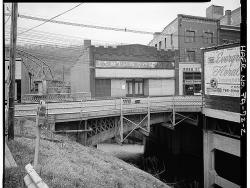
Not only was Dunlap's Creek Bridge the first cast-iron bridge in America, it was the first metal bridge anywhere to use what its builder, Capt. Richard Delafield, U.S. Army Corps of Engineers, described as "standardized, interchangeable, manufactured parts." The bridge was built as part of…
The Wheeling Suspension Bridge was the first bridge to span the Ohio River. It was initially completed in 1849, but destroyed by a tornado five years later. The bridge was rebuilt in 1856. The replacement bridge has the same general appearance of the original structure; the massive towers,…
Read More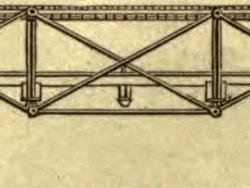
The Fink Deck Truss Bridge is thought to have been originally used on the Norfolk and Western mainline railway. It was moved to its present location and converted to a vehicular bridge over a railroad spur in 1893 when the Norfolk and Western mainline was moved. It was relocated again in 1985 to…
Read More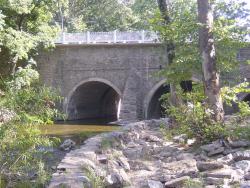
"For 273 years, the little stone bridge that carries Frankford Ave. across Pennypack Creek has been doing its humble job with a minimum of attention..."
- Gerald McKelvey, The Philadelphia Inquirer, September 16, 1970
Built more than a century before the reign of Napoleon,…
Read More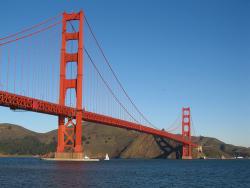
Put in service in 1937, this world-renowned bridge, conceived by Joseph Strauss and designed largely by Charles Ellis, was the longest single span (4,200 feet) in the world for a quarter century.
As with many civil engineering projects in their conceptual stages, naysayers scoffed at the…
Read More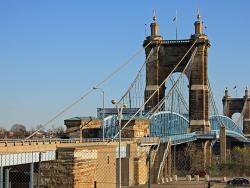
In 1866, the Covington and Cincinnati Suspension Bridge was the largest suspension bridge in the world. Also called the Ohio Bridge, it was officially renamed the John A. Roebling Bridge in 1983. It was the first permanent bridge over the Ohio River and the only public project in America…
Read More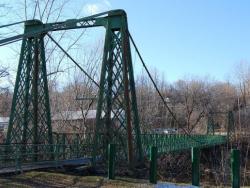
A 214-foot single-span covered wooden bridge, built above the cribs of stone in the AuSable River that served to break log jams and ice floes, collapsed during the winter of 1875 under the weight of a three-foot snowfall and high winds. The "Upper Bridge" (pictured) was built in its place.…
Read More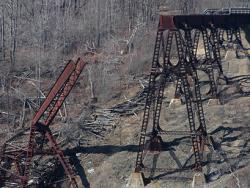
The workforce consisted of less than 100 men, yet they finished construction in just 94 days. Such speed was possible due to the elimination of scaffolding. Instead, iron rods were used to support construction of the trusses between the towers, and workers moved back and forth across the rods. A…
Read More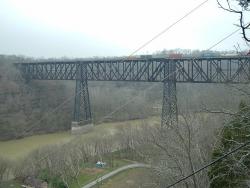
In the 1850s, the Lexington and Danville Railroad began building a suspension bridge over the Kentucky River. The bridge was designed by John A Roebling. Due to unforeseen increases in train loads, the Roebling bridge was never completed. The High Bridge would then be built 20 years later on the…
Read More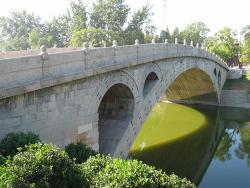
Ancient Chinese literature refers to the Zhaozhou Bridge as a "crescent moon rising from the clouds" or a "rainbow in the sky." Throughout its history, it has been known as the Anchi or Anji Bridge (literally "safe crossing"), the Dashi Bridge ("big stone"), and the Dashiqiao ("great stone")…
Read More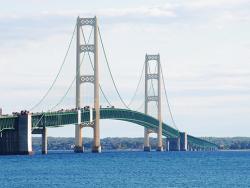
The Mackinac (pronounced "Mack-in-awe") Bridge (1957) spans the Straits of Mackinac between Lake Michigan and Lake Huron, connecting the Lower and Upper peninsulas of Michigan. Prior to the construction of the bridge, a fleet of nine ferries would carry as many as 9,000 vehicles per day, with…
Read More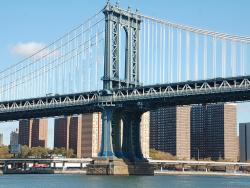
When opened in 1909, the 1,470 foot long main span of the Manhattan Bridge was the third longest suspension bridge span in the world, after the nearby Brooklyn and Williamsburg Bridges. The Manhattan Bridge has two 725 foot long suspended side spans for an overall length of 2,920 feet. The…
Read More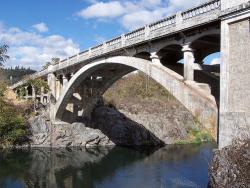
The Rogue River Bridge was the most advanced concrete bridge in America when it was built. Distinguished bridge engineer Conde McCullough employed the techniques of Frenchman Eugene Freyssinet to create thin, graceful concrete arches for this seven-span structure.
Pre-compression of the…
Read More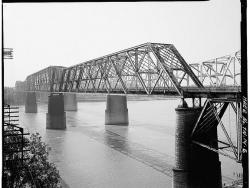
The Memphis Bridge (now called the Frisco Bridge) comprises three spans across the Mississippi River. With a main span measuring over 790 feet, it was one of the longest railroad bridges in the world upon completion. The renowned George Morison, after whom the bridge is unofficially named,…
Read More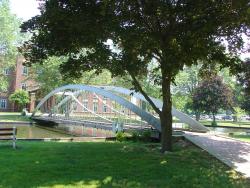
Designed, patented, and built by Thomas W.H. Moseley, this arched 96-foot span bridge preceded by years the standard use of wrought iron for bridges. For the first time in the United States, Moseley incorporated the use of riveted wrought-iron plates for the triangular-shaped top chord.
…
Read More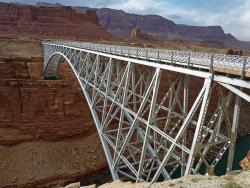
Navajo Bridge spans Marble Canyon, 470 feet above the Colorado River in Grand Canyon National Park. It was considered the highest steel arch bridge in America when completed.
The Navajo Bridge (also known as the Grand Canyon Bridge) was built in 1929 by the Arizona Highway Department and…
Read More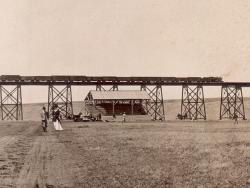
The Northern Pacific High Line Bridge No. 64, built between 1907 and 1908, has continued to perform yeoman service in the uninterrupted flow of the Nation's commerce. Nearly, 100 years after this bridge officially opened, it still carries 125-ton car unit coal trains, double stack container…
Read More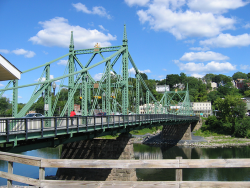
The crossing of the Delaware River at Easton, Pennsylvania, provided a central link in travel from the northeastern seaboard to America's inland territories throughout the 18th and early 19th centuries. From 1806 to the mid-1890s, travelers used a landmark wooden structure built by noted bridge-…
Read More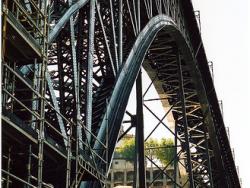
Built to cross one of the steepest valleys along the Douro River, the Ponte Maria Pia was the first major work to emerge from the French firm of Gustav Eiffel and Company, establishing Eiffel as an important bridge designer and civil engineer of his day. Resting on a parabolic arch spanning 160…
Read More

